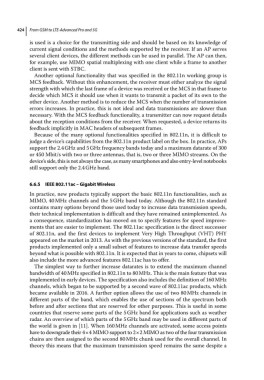Page 438 - From GMS to LTE
P. 438
424 From GSM to LTE-Advanced Pro and 5G
is used is a choice for the transmitting side and should be based on its knowledge of
current signal conditions and the methods supported by the receiver. If an AP serves
several client devices, the different methods can be used in parallel. The AP can then,
for example, use MIMO spatial multiplexing with one client while a frame to another
client is sent with STBC.
Another optional functionality that was specified in the 802.11n working group is
MCS feedback. Without this enhancement, the receiver must either analyze the signal
strength with which the last frame of a device was received or the MCS in that frame to
decide which MCS it should use when it wants to transmit a packet of its own to the
other device. Another method is to reduce the MCS when the number of transmission
errors increases. In practice, this is not ideal and data transmissions are slower than
necessary. With the MCS feedback functionality, a transmitter can now request details
about the reception conditions from the receiver. When requested, a device returns its
feedback implicitly in MAC headers of subsequent frames.
Because of the many optional functionalities specified in 802.11n, it is difficult to
judge a device’s capabilities from the 802.11n product label on the box. In practice, APs
support the 2.4 GHz and 5 GHz frequency bands today and a maximum datarate of 300
or 450 Mbit/s with two or three antennas, that is, two or three MIMO streams. On the
device’s side, this is not always the case, as many smartphones and also entry‐level notebooks
still support only the 2.4 GHz band.
6.6.5 IEEE 802.11ac – Gigabit Wireless
In practice, new products typically support the basic 802.11n functionalities, such as
MIMO, 40 MHz channels and the 5 GHz band today. Although the 802.11n standard
contains many options beyond those used today to increase data transmission speeds,
their technical implementation is difficult and they have remained unimplemented. As
a consequence, standardization has moved on to specify features for speed improve-
ments that are easier to implement. The 802.11ac specification is the direct successor
of 802.11n, and the first devices to implement Very High Throughput (VHT) PHY
appeared on the market in 2013. As with the previous versions of the standard, the first
products implemented only a small subset of features to increase data transfer speeds
beyond what is possible with 802.11n. It is expected that in years to come, chipsets will
also include the more advanced features 802.11ac has to offer.
The simplest way to further increase datarates is to extend the maximum channel
bandwidth of 40 MHz specified in 802.11n to 80 MHz. This is the main feature that was
implemented in early devices. The specification also includes the definition of 160 MHz
channels, which began to be supported by a second wave of 802.11ac products, which
became available in 2016. A further option allows the use of two 80 MHz channels in
different parts of the band, which enables the use of sections of the spectrum both
before and after sections that are reserved for other purposes. This is useful in some
countries that reserve some parts of the 5 GHz band for applications such as weather
radar. An overview of which parts of the 5 GHz band may be used in different parts of
the world is given in [11]. When 160 MHz channels are activated, some access points
have to downgrade their 4 × 4 MIMO support to 2 × 2 MIMO as two of the four transmission
chains are then assigned to the second 80 MHz chunk used for the overall channel. In
theory this means that the maximum transmission speed remains the same despite a

